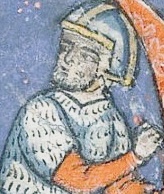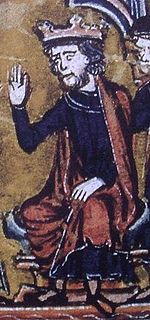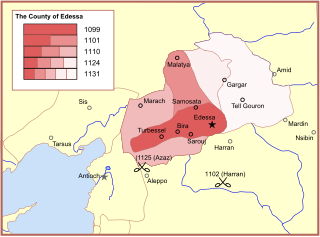
Ravendel was a castle located about 40 kilometers south-west of Turbessel within the County of Edessa. [1]

Ravendel was a castle located about 40 kilometers south-west of Turbessel within the County of Edessa. [1]
Ravendel [lower-alpha 1] was located in the fortified frontier zone ( al-'Awasim ) between the Muslims and Byzantines.
In late 1097 during the First Crusade, Ravendel was captured from its occupying Seljuk garrison by Baldwin I, with the support of the local Armenian population. [2] The castle was initially granted to the Armenian adventurer Bagrat Pakrad. [3] However, before departing for Edessa, Baldwin ordered the arrest of Bagrat, when Fer, ruler of Turbessel, had accused him of secret correspondence with the Seljuks. [4] [5] Bagrat was tortured and forced to surrender Ravendel. [4] [6] Ravendel was later given, along with Turbessel, to Godfrey of Bouillon, who ruled there in the summer of 1098. [7]
The castle was incorporated into the County of Edessa during the lordship of Joscelin I of Edessa, and later ruled by his son Joscelin II of Edessa. When Joscelin II was captured in 1150, his wife Beatrice of Saone ceded Ravendel along with other towns to the rule of Manuel I Komnenos. [8] In 1151, it was occupied by Joscelin II's captor Nur ad-Din, the Zengid emir of Aleppo.
After his conquest of Syria, Saladin had the castle and its town rebuilt. It was later controlled by the Mamluks, and was depopulated during the invasion of Timur in 1400.

The First Crusade (1096–1099) was the first of a series of religious wars, or Crusades, initiated, supported and at times directed by the Latin Church in the medieval period. The objective was the recovery of the Holy Land from Islamic rule. While Jerusalem had been under Muslim rule for hundreds of years, by the 11th century the Seljuk takeover of the region threatened local Christian populations, pilgrimages from the West, and the Byzantine Empire itself. The earliest initiative for the First Crusade began in 1095 when Byzantine emperor Alexios I Komnenos requested military support from the Council of Piacenza in the empire's conflict with the Seljuk-led Turks. This was followed later in the year by the Council of Clermont, during which Pope Urban II supported the Byzantine request for military assistance and also urged faithful Christians to undertake an armed pilgrimage to Jerusalem.

Baldwin I, also known as Baldwin of Boulogne, was the first count of Edessa from 1098 to 1100, and king of Jerusalem from 1100 to his death. He was the youngest son of Eustace II, Count of Boulogne, and Ida of Lorraine and married a Norman noblewoman, Godehilde of Tosny. He received the County of Verdun in 1096, but he soon joined the crusader army of his brother Godfrey of Bouillon and became one of the most successful commanders of the First Crusade.

Bohemond II was Prince of Taranto from 1111 to 1128 and Prince of Antioch from 1111/1119 to 1130. He was the son of Bohemond I, who in 1108 was forced to submit to the authority of the Byzantine Empire in the Treaty of Devol. Three years later, the infant Bohemond inherited the Principality of Taranto under the guardianship of his mother, Constance of France. The Principality of Antioch was administered by his father's nephew, Tancred, until 1111. Tancred's cousin, Roger of Salerno, managed the principality from 1111 to 1119. After Roger died in the Battle of the Field of Blood, Baldwin II of Jerusalem took over the administration of Antioch. However, he did acknowledge Bohemond's right to personally rule the principality upon reaching the age of majority.

Nūr al-Dīn Maḥmūd Zengī, commonly known as Nur ad-Din, was a member of the Oghuz Turkish Zengid dynasty, which ruled the Syrian province (Shām) of the Seljuk Empire. He reigned from 1146 to 1174. He is regarded as an important figure of the Second Crusade.

Baldwin II, also known as Baldwin of Bourcq or Bourg, was Count of Edessa from 1100 to 1118, and King of Jerusalem from 1118 until his death. He accompanied his cousins Godfrey of Bouillon and Baldwin of Boulogne to the Holy Land during the First Crusade. He succeeded Baldwin of Boulogne as the second count of Edessa when he left the county for Jerusalem following his brother's death. He was captured at the Battle of Harran in 1104. He was held first by Sökmen of Mardin, then by Jikirmish of Mosul, and finally by Jawali Saqawa. During his captivity, Tancred, the Crusader ruler of the Principality of Antioch, and Tancred's cousin, Richard of Salerno, governed Edessa as Baldwin's regents.

The County of Edessa was one of the Crusader states in the 12th century. Its seat was the city of Edessa.

The Crusader States, also known as Outremer, were four Roman Catholic realms in the Middle East that lasted from 1098 to 1291. These feudal polities were created by the Latin Catholic leaders of the First Crusade through conquest and political intrigue. The four states were the County of Edessa (1098–1150), the Principality of Antioch (1098–1287), the County of Tripoli (1102–1289), and the Kingdom of Jerusalem (1099–1291). The kingdom of Jerusalem covered what is now Israel and Palestine, the West Bank, the Gaza Strip, and adjacent areas. The other northern states covered what are now Syria, south-eastern Turkey, and Lebanon. The description "Crusader states" can be misleading, as from 1130 very few of the Frankish population were crusaders. The term Outremer, used by medieval and modern writers as a synonym, is derived from the French for overseas.

The Principality of Antioch was one of the crusader states created during the First Crusade which included parts of modern-day Turkey and Syria. The principality was much smaller than the County of Edessa or the Kingdom of Jerusalem. It extended around the northeastern edge of the Mediterranean, bordering the County of Tripoli to the south, Edessa to the east, and the Byzantine Empire or the Kingdom of Armenia to the northwest, depending on the date.

Joscelin of Courtenay, Prince of Galilee and Lord of Turbessel (1115–1131) and Count of Edessa (1119–1131), ruled over the County of Edessa during its zenith, from 1118 to 1131. Captured twice, Joscelin continued to expand his county, even participating in the Battle of Azaz in 1125. Gravely injured during the collapse of a sapper mine, Joscelin marched his army to relieve the besieged fortress of Kaysun, and died soon after.

Joscelin II of Edessa was the fourth and last ruling count of Edessa. He was son of his predecessor Joscelin I of Edessa and Beatrice, daughter of Constantine I of Armenia.
Turbessel is a fortress and Bronze Age tumulus in south-eastern Turkey, near the village of Gündoğan in the district of Oğuzeli, within Gaziantep Province.
The siege of Edessa took place from November 28 to December 24, 1144, resulting in the fall of the capital of the crusader County of Edessa to Zengi, the atabeg of Mosul and Aleppo. This event was the catalyst for the Second Crusade.
The Crusades were a series of religious wars initiated, supported, and sometimes directed by the Latin Church in the medieval period. The best known of these Crusades are those to the Holy Land in the period between 1095 and 1291 that were intended to recover Jerusalem and its surrounding area from Islamic rule. Concurrent military activities in the Iberian Peninsula against the Moors and in northern Europe against pagan West Slavic, Baltic and Finnic peoples also became known as crusades. Through the 15th century, other church-sanctioned crusades were fought against heretical Christian sects, against the Byzantine and Ottoman empires, to combat paganism and heresy, and for political reasons. Unsanctioned by the church, Popular Crusades of ordinary citizens were also frequent. Beginning with the First Crusade which resulted in the recovery of Jerusalem in 1099, dozens of Crusades were fought, providing a focal point of European history for centuries.
Mawdud ibn Altuntash was a Turkic military leader who was atabeg of Mosul from 1109 to 1113. He organized several expeditions to reconquer lands from the Crusaders, but never succeeded.

Thoros was an Armenian ruler of Edessa at the time of the First Crusade. Thoros was a former officer (curopalates) in the Byzantine Empire and a lieutenant of Philaretos Brachamios. He was Armenian but practiced the Greek Orthodox faith.

The timeline of the Principality of Antioch is a chronological list of events of the history of the Principality of Antioch.
Beatrice of Saone was countess of Edessa from 1134 to 1150. Her first husband, William of Zardana, died in 1132 or 1133, leaving her in the possession of the fortress of Saone in the Principality of Antioch. She soon married her late husband's close ally Count Joscelin II of Edessa. After her husband was captured by troops of Nur ad-Din, the atabeg of Aleppo in May 1150, Beatrice entered into negotiations about the sale of the remnants of the County of Edessa to the Byzantine Empire. After the transfer was completed in August 1150, she and her children settled in Saone.
The siege of Aleppo by Baldwin II of Jerusalem and his allies lasted from 6 October 1124 to 25 January 1125. It ended in a Crusader withdrawal following the arrival of a relief force led by Aqsunqur al-Bursuqi.
Bagrat Pakrad, also known as Bagrat or Pakrad, was an Armenian adventurer and brother of Kogh Vasil. He befriended Baldwin I in his march to the Euphrates and was given command of the critical fortress Ravendel. Out of jealousy, Fer, the Armenian noble who ruled Turbessel, reported to Baldwin that Bagrat was conspiring against him. Suspected of collaboration with the Turks, he was arrested and tortured, only to escape to the mountains with his brother. Bagrat became lord of Khoros (Cyrrhus) in 1116 and was defeated by Baldwin.
The siege of Edessa in October–November 1146 marked the permanent end of the rule of the Frankish Counts of Edessa in the city on the eve of the Second Crusade. It was the second siege the city had suffered in as many years, the first siege of Edessa having ended in December 1144. In 1146, Joscelyn II of Edessa and Baldwin of Marash recaptured the city by stealth but could not take or even properly besiege the citadel. After a brief counter-siege, Zangid governor Nūr al-Dīn took the city. The population was massacred and the walls razed. This victory was pivotal in the rise of Nūr al-Dīn and the decline of the Christian city of Edessa.
{{cite book}}: CS1 maint: ref duplicates default (link)(registration required)